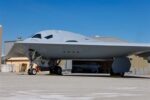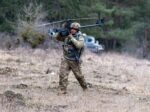The Royal Navy has launched a new effort to develop an unmanned collaborative combat aircraft (CCA) to operate alongside its F-35B Lightning II stealth fighters from Queen Elizabeth-class aircraft carriers. This loyal wingman-style initiative marks a significant leap in the UK’s maritime aviation ambitions and aligns with broader trends in manned-unmanned teaming across NATO and allied forces.
UK’s Naval Aviation Strategy Enters the Unmanned Era
At the 2025 DSEI conference in London and through subsequent Ministry of Defence (MOD) briefings, it was revealed that the Royal Navy is actively seeking industry proposals for an unmanned aerial platform capable of operating from aircraft carriers and collaborating with manned fighters. The goal is to field a system that can extend the reach of carrier strike groups while reducing risk to pilots and high-value assets.
The envisioned platform will support missions such as ISR (intelligence, surveillance, reconnaissance), electronic warfare (EW), decoy operations, and potentially strike. It must be compatible with short take-off and vertical landing (STOVL) operations or alternative launch/recovery systems suitable for Queen Elizabeth-class carriers. This requirement reflects the unique constraints of the Royal Navy’s carrier design compared to catapult-assisted take-off but arrested recovery (CATOBAR) systems used by U.S. carriers.
Program Origins and Strategic Context
This initiative builds upon earlier UK research into unmanned combat systems under programs like LANCA (Lightweight Affordable Novel Combat Aircraft), which led to the development of the Mosquito demonstrator before its cancellation in 2022. Lessons learned from LANCA are now being repurposed under broader Team Tempest efforts within the Future Combat Air System (FCAS), which envisions a family-of-systems approach combining manned platforms like Tempest with autonomous UCAVs.
The Royal Navy’s loyal wingman concept is distinct from but complementary to RAF FCAS plans. While FCAS focuses on air superiority in contested airspace over land or near-peer theaters like Eastern Europe or Indo-Pacific regions, the naval variant prioritizes maritime domain awareness, anti-access/area denial (A2/AD) penetration near littorals, and survivability against integrated air defense systems (IADS).
Rear Admiral James Parkin, Director Develop at UK Strategic Command, emphasized during DSEI that “the future of carrier aviation must integrate autonomous systems—not just as force multipliers but as essential components of survivability.”
Technical Requirements and Operational Roles
The MOD has not released final specifications but has outlined key capability areas:
- Carrier Compatibility: Must launch/recover from Queen Elizabeth-class decks without catapults/arrestor gear; STOVL or alternative VTOL/launch-assist concepts preferred.
- MUM-T Integration: Seamless data-linking with F-35Bs via Link-16 or native MADL; AI-enabled autonomy for semi-independent operation.
- Mission Flexibility: ISR/EW/strike modular payload bays; open architecture for rapid reconfiguration.
- Stealth/Sensor Fusion: Low observable design with integrated EO/IR/RF sensors; potential role as forward sensor node for F-35Bs.
- Aerial Refueling Capability: Not initially required but may be considered for future spiral development phases.
The aircraft would ideally accompany F-35Bs into contested zones—scouting ahead using passive sensors or jamming enemy radars—while relaying data back via secure tactical networks. In strike roles, it could carry stand-off munitions such as SPEAR-EW or MBDA’s Select Precision Effects At Range series.
Industry Engagement and Potential Contenders
The MOD has issued Requests for Information (RFIs) through DE&S’ Future Maritime Aviation Force team. While no formal downselect has occurred yet, several UK-based defense primes are expected to compete or collaborate:
- BAE Systems: Drawing from its work on Tempest and Taranis UCAV demonstrator; likely front-runner given experience with stealth UAVs.
- Cranfield Aerospace / Blue Bear Systems Research: Known for modular UAV designs under LANCA; could offer smaller tactical platforms.
- Team Resolute / Leonardo UK: May contribute sensor fusion or EW payloads based on their naval integration experience.
- Boeing Defence UK: Could adapt MQ-28 Ghost Bat concepts if interoperability agreements allow export adaptation.
- KraytWorks / Aeralis Ltd: Startups offering modular jet architectures may propose novel approaches tailored to STOVL ops.
A key challenge will be designing an airframe that balances performance with deck-handling constraints aboard STOVL-configured ships lacking catapults/arrestor wires. Concepts involving assisted launch rails or drone-specific elevators are reportedly under study by Babcock International and QinetiQ naval architecture teams supporting ship-air integration trials at RNAS Culdrose test sites.
Toward Carrier Strike Group Autonomy
This program fits within a broader Royal Navy vision called “Carrier Strike Group Autonomy,” which seeks greater distributed lethality through networked unmanned systems across domains—surface drones (USVs), underwater vehicles (UUVs), and aerial assets working together via C4ISR nodes aboard HMS Queen Elizabeth-class vessels or Type 83 destroyers under development.
If successful, this loyal wingman initiative could enable distributed kill chains where unmanned scouts detect threats beyond radar horizon while cuing missiles launched by other nodes—either manned jets or surface ships. The concept mirrors U.S. Navy Distributed Maritime Operations doctrine but adapted for Britain’s smaller fleet size and expeditionary posture focused on NATO flanks and Indo-Pacific partnerships like AUKUS/JEF deployments.
Tentative Timeline and Funding Outlook
The MOD aims to downselect concepts by late FY2026 following initial feasibility studies in FY2025–26. A demonstrator flight trial could occur by FY2028 if funding remains consistent under Defence Equipment Plan allocations tied to FCAS integration tracks. Full operational capability might follow in early-to-mid-2030s depending on technical risk reduction milestones met during prototyping phases led by DSTL/QinetiQ test regimes at Boscombe Down or Hebrides ranges.
No exact budget figures have been released yet; however, estimates suggest initial investments in excess of £250 million over five years may be required for prototype development alone—excluding shipboard modifications needed for drone handling/storage aboard carriers. Parliament’s Defence Committee has requested quarterly updates given strategic implications tied to Indo-Pacific tilt priorities post-AUKUS Pillar II announcements involving AI/autonomy cooperation among allies.










